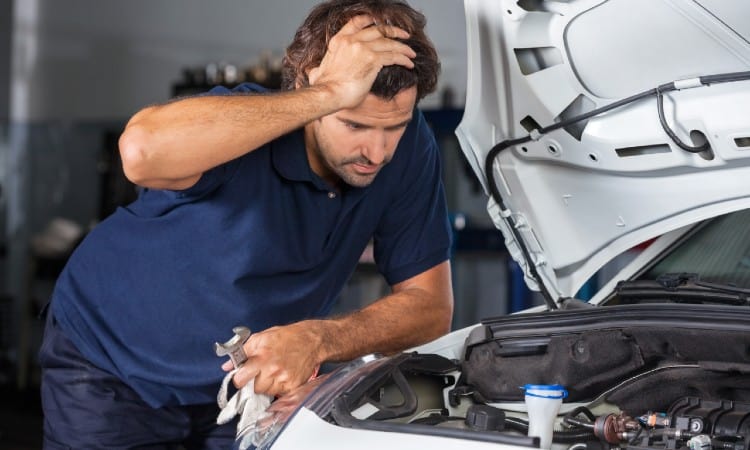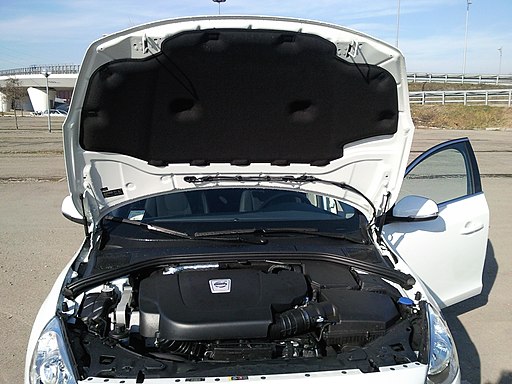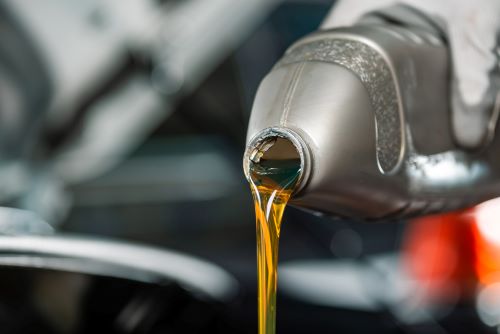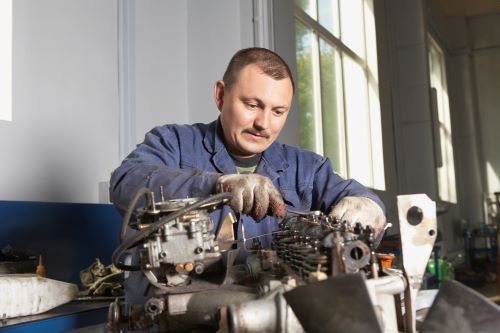Have you ever turned the steering wheel and heard a whine or another noise? Sounds that aren’t related to what is commonly heard from under the hood are trying to tell you something. Usually, that something is wrong. Understanding what power steering pump noise could mean is the first step to fixing what is behind the sound.
Power Steering Pump Noise: How to Diagnose and Fix. A whine could mean a loose, damaged, or wet serpentine belt. Grinding or squeaking may indicate the power steering fluid is low, leaking, has air bubbles, or that the reservoir filter is dirty. A rattle could be a loose pulley or failing pump. The sound helps identify what to repair.
In this article, we describe the power steering system and what it does. We review the noises you may hear and what they mean. We’ll also explore what may cause different sounds, their symptoms, and how to repair them. When you’ve completed the article, you’ll better understand what steering system noises are trying to tell you, and how to repair them.
For more information on diagnosing and fixing automotive noise please see the following articles:
How to Soundproof a Noisy Water Pump
How to Quiet Noisy Strut Mounts

What Is a Power Steering System and What Does it Do?
Power steering replaced arm-strong steering and made it easier to steer a vehicle. Power-assisted steering was invented in the 1920s but didn’t hit the commercial automobile market until 1951. It uses electric or hydraulic actuators to make it easier to turn a vehicle, especially at lower speeds.
Before power assist, drivers used arm strength to strong-arm the vehicle to turn. It is often referred to as arm-strong steering. Using two hands to force a vehicle through a curve or turn was common, and more effort was needed at low speeds. The addition of power assistance made it possible to turn the wheel easily, even when the vehicle is parked.
The two prevailing steering gear systems today are recirculating ball and rack-and-pinion. The recirculating ball system is commonly found on rear-wheel-drive vehicles, while the rack-and-pinion is the main choice for front-wheel drive vehicles. The orientation of the engine and its oil pan are the main reason for which system is used.
The ball system was used in most vehicles prior to the 1980s, but today is only used in some trucks, SUVs, and off-road vehicles. It uses a ball and nut or worm-gear and nut mechanism to decrease steering effort. The system has more moving parts, weighs more than rack-and-pinion, and is more expensive. It is a smaller, stronger, more durable system, and provides more ground clearance.
Rack-and-pinion has a pinion gear that meshes with a rack – a rod with antler-like teeth. Turning the steering wheel turns the pinion. The pinion gear teeth move the steering rack left or right, depending on the rotation of the steering wheel. The rack connects to a tie rod at each end, and then to the steering arm and wheel assembly. The system is common on front-wheel drive vehicles. It has fewer moving parts and weighs less.
The recirculating ball and rack-and-pinion systems, along with other types of steering systems, use hydraulic power to assist with steering. They utilize a belt-driven rotary vane pump to circulate and pressurize hydraulic fluid to and from the steering mechanism through high-pressure hoses. The pressurized fluid decreases the effort required to steer.
Power Steering Noises and What They Mean?
The power steering system is made up of different components that make it possible to steer a vehicle more easily. From the belt that drives the power steering pump pulley to the ball joints and tie-rod ends at the tire hub, all the parts work together to manipulate a vehicle. The moving parts usually work quietly together. However, dirty, damaged, or failing components can produce different noises. The noises help to identify what part may require maintenance or replacement.
Power Steering Pump Whine Noise
Power steering whine often indicates a cause for concern. If a power steering whining noise occurs only at start-up or on damp days and then disappears, it is most likely moisture on the drive belt or pulley. If it happens when steering, check the serpentine belt for wear or damage, pulley and belt alignment, and leaks in the high-pressure hoses. If everything checks out, there may be air in the power steering fluid, causing it to whine.
Grinding
Grinding can be caused by low power steering fluid, or by air trapped in the system. Recent repairs or a leak may be the reason for low fluid levels or air in the system. Hearing the noise when turning at low speeds may also indicate the outer constant-velocity (CV) joint is failing.
The joint connects the drive wheels with the drive shaft. Grease on the ground or the inside of the rim, combined with the grinding noise, are signs of a damaged outer CV. It could be the bearings too.
Squeaking
A squeak that happens after several quick turns can be caused by the power steering fluid level being low, which is the result of a possible leak. It could also be that the fluid reservoir filter needs cleaning or replacing. Squeaking may indicate that the serpentine belt is slipping.
Slippage may be from a worn or damaged belt or moisture or contaminants on the pulleys or belt. A failing power steering pump could be the culprit too.
Groaning Noise
A groaning and whining sound, coupled with stiff or unresponsive steering may be a warning that the power steering fluid level is low, or the pump needs replacing. Not only is this a safety concern, but it can also damage other parts of the steering system. If the power steering noise only happens at low speed turns and not higher speeds, it may be air bubbles in the system.
Rattle
A rattle from power steering pumps when turning the steering wheel or parked is often due to low steering fluid or a pump beginning to fail. A loose power steering pump pulley or mounting bracket will make a rattling sound too. A rattle sound can be caused by a loose rack due to wear. It could also indicate a loose serpentine belt or idler pulley bearings beginning to fail.
Bearing Noise
The power steering impeller bearings may squeal, whine or grind if they are damaged. They can harm the pump further, plus hurt other parts of the steering system. Wheel bearings that make a grinding sound when turning can impede steering and should be replaced.
The bearings are located between the wheel and the axle and decrease friction for smooth turns. A grinding noise when turning can mean a bearing is worn or failing.
10 Causes of Noisy Power Steering Pump
Power steering pump noise indicates that there is something wrong. If may be a quick fix or one that needs to go to the shop. The longer you wait, the worse it may become.
1. Low Level of Power Steering Fluid
Power steering fluid is used to make turning easier. It is a hydraulic fluid that is circulated through high-pressure hoses by the pump and helps lubricate and cool parts. Low power steering fluid level often means there is a leak in the system.
A leak may allow air into the system and cause a squeaking, rattling, groaning, or grinding noise when steering. Low fluid makes steering more difficult, can degrade the fluid through overheating, and damage the steering gear.
2. Leak in the Power Steering Pump
A power steering pump leak will leave a puddle of reddish-brown liquid under the front of your car. The leak may be where the drive pulley shaft enters the pump, or where the hoses connect to the pump. A leak will lead to low hydraulic fluid levels, which can cause fluid to overheat and degrade. It can also damage other power steering components.
3. Worn out Steering Fluid
Power steering fluid is a silicone or mineral oil based hydraulic fluid, or it could have a synthetic oil base. The fluid is used to make steering easier, and to cool and lubricate parts.
Over time, it wears out or degrades which can cause a grinding noise and reduced steering efficiency. It can also become contaminated with microscopic particles of metal, rust, and rubber. The build-up of particles can clog the filter or clog and damage the pump.
4. Air in Power Steering Pump
Air in the power steering pump can create an air pocket, making steering more difficult and causing a groaning sound. The air gets trapped, compressed, and interferes with the function of the hydraulic fluid. Air bubbles or foam in the fluid reservoir is another indication that there is air in the system too.
5. Slipping or Worn Power-Steering Belt
A slipping or worn power steering belt can cause a whine, squeal, chirp, or grind at start-up and when steering. The belt provides power to the power steering pump, so slippage can interfere with power assistance, making steering difficult.
If the belt is serpentine, it powers other important auxiliary parts of the vehicle. If it is slipping or worn, it will affect the alternator, a/c, and possibly the cooling system pump.
6. Worn out Power Steering Pump
The power steering pump provides the pressurization for the hydraulic fluid that makes steering almost effortless. A worn or failing pump will make a whine at ignition and a squeal when steering. There can also be a response delay of a couple of seconds when turning and steering may become stiffer. A pump wearing out may develop a leak of hydraulic fluid too, so watch for reddish-brown puddles under the front end.
7. Issues in the Design of the Pump
Some power steering pumps are poorly designed or manufactured with cheap parts. They can fail without warning, leaving you with no power-assisted steering. Some develop leaks, while others suffer bearing or pulley axle damage.
Squealing, groaning, or whining noise by a new pump or one in a new vehicle may be a warning of a dud pump. Some pumps do get recalled, but damage to other components that aren’t covered may already exist.
8. Clogged Power Steering Hose
A clog in a power steering hose can cause stiff steering, fluid leaks, and low fluid levels in the reservoir. You may hear a power steering whine, whistle, or grinding noise as hydraulic fluid movement is impeded. The blockage may be due to contaminants like metal, plastic, or rubber that prevent flow through openings or cause the flow valve to stick. A clog can cause the fluid to boil and also damage other steering components.
9. Defective Power Steering Pump
A defective steering pump may whine, grind, or squeal due to parts not working as they should. It may develop a leak, causing low fluid, which in turn can superheat the fluid and crack the reservoir or damage other steering system parts. Steering may become difficult, or erratic – easy or loose sometimes and hard at others.
10. Wobbly Pulley or Leaked Pulley Seal
A wobbly power steering pulley can squeal like a banshee. It can damage the woodruff key or damage the shaft or key slot, leading to a pricey repair. It may also cause belt wear or slippage, which creates other issues.
A pulley seal leak will leave reddish-brown puddles or stains under the vehicle, and lead to a whistle, squeal or grinding sound. The leak may be caused by age, pressure, wear, or corrosion and result in damage to the pump or other components.
Symptoms of a Bad or Failing Power Steering Pump
Power steering using a belt-driven, rotary vane pump circulates hydraulic fluid through high-pressure hoses to the steering gear and back to the reservoir. It provides the necessary force to steer a vehicle smoothly and easily. If the pump is bad or failing, it can cause irritating sound and pose a safety risk. Here are some signs and symptoms to watch for:
If the steering is stiff, it may mean the power-assist from the hydraulic fluid is failing due to the pump struggling to do its job. A slow response to the steering wheel when turning, coupled with a whining noise, means the pump could be failing too. The pump may provide other signs it is going bad. Unusual noises coming from under the hood are trying to tell you what is happening.
Power steering making noise when accelerating often indicates a problem within the steering system. It may be the power-steering belt, pulley, or pump. Sounds that occur when it’s cold can mean there is air in the steering system, which indicate a fluid leak due to a seal, O-ring, or hose failing. Noises that only happen when starting the vehicle may also be due to air in the system, or the belt is losing its elasticity.
Sounds that occur when turning the wheel can indicate a variety of concerns. A power steering whine could be due to a failing steering pump, a groan to low fluid, or air in the system. A rattle could be a loose pulley, worn rack, or failing pulley bearing.
The pump pressurizes the fluid, which makes steering easier. A failing pump may develop a fluid leak or a wobbly pulley. A leak can damage other components of the steering system, and the pulley can damage the belt and pump shaft, but the pump is often the culprit.
How to Fix Power Steering Pump Noise
Fixing noises caused by a power steering pump is something you can do yourself, or hire a licensed mechanic that you trust do the work. Identifying the source, or eliminating sources, should help narrow down the cause and make repairs easier. Stay safe and keep clothing, hair, and body parts away from moving engine parts.
1. Diagnose and Identify the Noise Source
Turn on your engine. If there is a whine or other noise that disappears shortly after starting, it is probably a bit of moisture or dampness on the belt. If the noise persists at idle or when increasing the RPMs, consider checking for a loose or worn belt.
Having a helper makes it easier to identify noise location and source. With the engine running, turn the wheel hard left and then hard right. Identify the type of sound – whine, squeak, squeal, screech, groan, grind, rattle, or clunk. A clunk is a sound you hopefully don’t hear.
With the engine off, check the belt for wear, damage, tension, and alignment. Make sure the pump pulley is in good condition, and the pump mount is secure and tight.
Look for reddish-brown oil drips or splatter around the pump, hoses, and fluid reservoir. Check the power steering fluid level, and observe if there are bubbles or foam around the edges.
2. Top Up Power Steering Fluid
The power steering reservoir cap commonly has a dip-stick attached, or the reservoir itself has max-min level lines on the sides. Check the owner’s manual if all else fails. Use approved power steering fluid to top up the level; do not overfill the reservoir. Wipe up any drips and replace the cap.
The fluid should be pinkish, amber, or clear. If it is a dark color like reddish-brown or black, it has contaminants in it, which indicates seals, rings, or other steering components are failing. The dark color, combined with a low-level reading is a good indication that there is a leak in the system.
3. Remove Air From Power Steering
With the engine off and cool, remove the reservoir cap. Check the fluid level and top up to the full-line if necessary. Replace the cap and follow the high-pressure line from the power steering pump toward the steering box to find the bleed valve on the line.
Push a hose onto the end of the valve. The hose should be long enough to reach a drain pan or container on the ground. Turn the vehicle on and then slightly loosen the valve. Turn the steering wheel as far to the left and right as possible. Turn the engine off and close the bleed valve.
Top up the reservoir. Check the fluid in the drain pan or container. If there are air bubbles, repeat the procedure until there are no bubbles. Remember to top up the reservoir after each bleed. If you can’t get rid of the bubbles, there is a leak somewhere drawing air into the system.
4. Change Power Steering Fluid
 The power steering fluid should be changed if it is reddish-brown or black. A good practice is every 24,000 miles or 2-years. Only use the manufacturer’s recommended fluid and have enough on hand to do the job. Beware of leak-stop or miracle products, as they can clog filters and result in expensive repairs. It’s better to fix the problem than mask it.
The power steering fluid should be changed if it is reddish-brown or black. A good practice is every 24,000 miles or 2-years. Only use the manufacturer’s recommended fluid and have enough on hand to do the job. Beware of leak-stop or miracle products, as they can clog filters and result in expensive repairs. It’s better to fix the problem than mask it.
Make sure the vehicle is off and remove the reservoir cap. Use a turkey baster type tool to empty the reservoir. Refill it with new fluid and replace the cap. Run the engine on for 15 to 20 seconds, and then turn off. Repeat the process until a full quart of fluid has been swapped out for new. Take the old hydraulic fluid to a recycling center unless you have a waste oil burning stove or heater.
5. Unclog the Power Steering Hose
Check the steering system filters for clogs before deciding it is a blocked hose. If they are clear, then plan to clear the lines. A power steering hose can become clogged by particles corroded or worn from other components.
A part of the hose lining may also separate if it has been pinched or damaged, causing an intermittent blockage. A clog may happen at an orifice at a connection, or within the hose. Another blockage source could be a sticking flow control valve.
Flushing the system should remove clogs caused by particles, but replacing damaged hoses may also be required. Check the owner’s manual for the recommended flush procedure and schedule. It is easier if the automobile is on a hoist or jack-stands, so access to the underside is possible. The wheels can also be turned left or right.
Remove the reservoir lid. To improve access to the steering lines, remove the catch tray if there is one. If there is fluid in the tray, there’s probably a leak. Place a catch-pan to collect flushed fluid.
Gently disconnect hoses from the reservoir to the steering rack to improve drainage. Remove the low-pressure hose at its lowest point on the pump and drain.
Fill the reservoir halfway with the recommended fluid. Have a helper turn vehicle on and turn the steering wheel left and right. Keep refilling the reservoir with clean fluid. When the fluid coming out is new, turn the engine off and reconnect hoses.
Top-up the reservoir and turn the car on. Steer right and left to circulate the hydraulic liquid through all components. Remove any air from the system too.
6. Adjust Power Steering Belt
Make sure the engine is off and cool. Check that the pump pulley and next pulley along the belt are parallel. Place a straight edge on the belt where it goes over the two pulleys.
Using a tape measure, measure how far from the straight edge you can push the belt inward using your thumb. Compare the inflection distance with the owner’s manual. It should be about 3/8”.
If the belt is too tight or loose, it requires adjustment. Loosen the adjustment bolt and slacken the pivot bolt(s) so the pump can move. The pump will move if the belt is too tight. Don’t let it move too much.
If it does or is loose, use a lever on the cast iron housing to push the pump upward. Don’t lever against soft metal or pipes as that can cause damage. Check the tension until it is correct. Tighten the bolt(s) to the correct torque, and recheck the belt inflection.
7. Replace the Belt
If the power-steering or serpentine belt is worn or damaged, remove it. Take a picture before removal, so installation matches. Check the manual for instructions and belt size and installation pattern.
Loosen the adjustment and pivot bolts and let the pump gently drop. Do not let it fall or push against fittings or other metal as in may cause damage. Remove the worn belt and wipe clean the pulleys.
Slide the new belt onto the pulleys in the same pattern as the originals. Lift the pump to tighten. Check the belt tension and tighten the bolts.
Recheck the tension and adjust the pump accordingly, and then torque the bolts. Do one final check of the inflection to ensure nothing changed. After about 100 to 150 miles, check the tension, and adjust if required.
8. Replace Power Steering Pump
Replacing the power-steering pump with a new or reconditioned pump should address most steering noise and problems. It needs to be installed correctly and may require the replacement of some pressure hoses and fittings, plus belt replacement and alignment. It may also be wise to clean the filters and flush the hydraulic fluid and replace it with new.
To replace the pump, ensure the engine is off and cool. Loosen the pivot and adjustment bolts for the pump, and remove the belt.
Place a drain pan underneath to catch the fluid. Disconnect the pressure hoses and any other connections or lines. Remove the mounting bracket bolts and take off the pump.
Bolt the new pump to the bracket and reconnect the hoses and lines. If the belt is worn or damaged, replace it with a new one. Replace the belt on the pulleys in the same pattern.
Adjust the tension and tighten all bolts, checking the tension repeatedly. Refill the reservoir with the recommended fluid. Turn the engine on, run for a couple of minutes, and check for leaks.
Turn the vehicle off, check fluid levels, top-up, and restart the engine. Turn the steering wheel hard left and right, it should turn easily and quietly. Turn the engine off and check the fluid level, repeat if necessary.
9. Get a Professional Inspection
Listening to your vehicle and identifying unusual sounds and when they occur, including the weather, make diagnosing power steering issues easier. Whether you plan to do the repair yourself or take it to a repair shop for professional assistance, the noise and when and where it occurs is important.
Check the owner’s manual for the recommended power steering maintenance schedule and suggestions. Checking the reservoir level and belt inflection when the oil is changed is also a good practice. Only use recommended fluid, and keep records of your maintenance.
Taking your car for a professional inspection may eliminate costly repairs. It often involves a power steering pressure test to make sure the pump is operating with its parameters. The inspection process checks fluid level and condition, belt condition, hoses, control valve, pressure relief valve, and the hydraulic power piston. Problems or concerns will be documented, and recommendations made.
Conclusion
Power steering pump noises are an indication that something is wrong with your steering system. It isn’t something that should be ignored or given a quick fix with an off the shelf miracle product. The hydraulic assist system is a fine balance that makes steering easy and still keeps you in touch with road conditions.
Being able to diagnose different steering noises and make repairs is a rewarding ability. However, sharing the information about the power steering noise with a licensed mechanic will assist with repair.
Whether you do it yourself or hire a professional, hopefully, you have a better understanding of what power steering whine, grind, or streaks mean. If you found this article of interest, please share it. As always, your comments and suggestions are appreciated.
You May Also Like:





I found this article very informing and enlightening.
Hi Johann,
Good to hear that you liked it.
Terry
Excellent article.